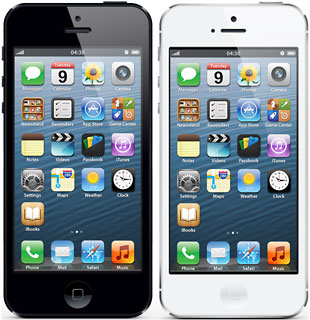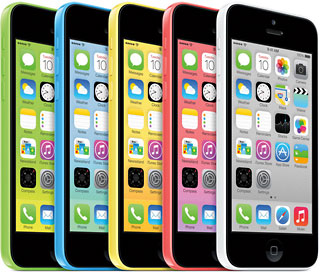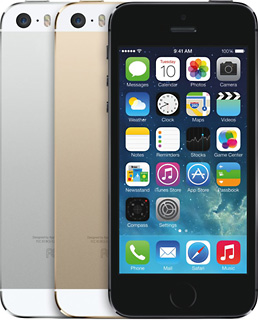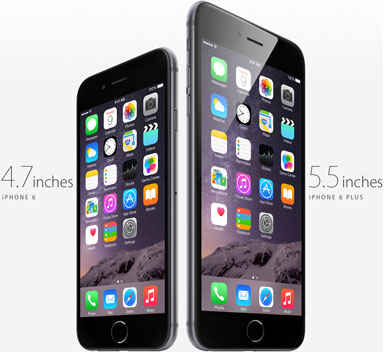Prior to the September 2012 introduction of the iPhone 5, every iPhone had used a 3.5″ display. Since the iPhone 5, all screens have been larger than that. At the same time, Apple abandoned the 30-pin dock connector it had inherited from iPods and adopted the new Lightning connector. This also marked the debut of 4G LTE support on the iPhone.
iPhone 5
 The first five generations of iPhone all included a screen with a 3:2 aspect ratio, the same as a 35mm camera and a 4″ x 6″ print. Starting with the iPhone 5, the new standard approximates 16:9 displays, the same aspect ratio as HD TV.
The first five generations of iPhone all included a screen with a 3:2 aspect ratio, the same as a 35mm camera and a 4″ x 6″ print. Starting with the iPhone 5, the new standard approximates 16:9 displays, the same aspect ratio as HD TV.
The new 4.0″ screen has a 640 x 1136 pixel resolution as the same 326 pixels per inch (ppi) as the Retina Display on the iPhone 4 and 4S. The new display has 18.3% more pixels than the iPhone 4 and 4S, and this allows for a fifth row of apps on the screen. The new display also had the richest color saturation yet on an iPhone.
The iPhone 5 left behind the glass back of the iPhone 4 and 4S in favor of a new machined aluminum case, and this helped make the iPhone 5 the thinnest iPhone to date at 0.30″ (7.6 mm) thick. At 20% thinner and 30% lighter than the iPhone 4S, it was the smallest iPhone yet.
Although the camera has the same 8 MP resolution as the one in the 4S, the new iPhone works better in low light. The FaceTime camera was upgraded to 1.2 MP, four times that of the iPhone 4 family. A third microphone was added to further improve noise reduction.
But more than anything else, the iPhone 5 was wicked fast, benchmarking at over 3x the score of the iPhone 4S on multi-core Geekbench 3! This comes from running its 1.3 GHz CPU at full speed vs. the 4S running at 800 MHz and doubling system memory (RAM) from 512 MB to 1 GB.
Unlike the iPhone 4S, where one model supported GSM and CDMA in all markets, there were three separate versions of the iPhone 4: one for CDMA and two for GSM networks, one for North America and the second for other markets.
The iPhone 5 was the first iPhone to support 802.11n WiFi using the 5 GHz band; earlier models were limited to 2.4 GHz for WiFi connectivity.
- 1.3 GHz dual-core Apple A6 SoC
- 1 GB of system memory
- 24-bit Retina Display with oleophobic coating
- 8 MP iSight camera with infrared filter, autofocus, automatic white balance, macro focus, tap to focus, and image stabilization
- 1080p video support
- video out via AirPlay or AV cables
- 1.2 MP 480 x 640 FaceTime camera with 720p video support
- voice control
- digital compass
- magnetometer
- 3-axis gyroscope
- Bluetooth 4.0
- 802.11n WiFi, 2.4 and 5.0 GHz
- supports 4G LTE
- 16, 32, and 64 GB versions
- Geekbench 3 multi-core score: 1271
- runs iOS 6 to iOS 9
The iPhone 5 hit the market on September 12, 2012. Apple received over 2 million preorders in the first 24 hours of online ordering, and over 5 million units were sold during its first three days of retail sales.
Like the original iPhone, the iPhone 5 was only on the market for one year and then discontinued – although the iPhone 5 was reborn with a new skin.
iPhone 5C
 The iPhone 5 was discontinued after one year on the market and replaced by the iPhone 5C, which was in almost every respect the iPhone 5 in a colorful – green, blue, yellow, pink, or white – polycarbonate enclosure. There is a steel band to strengthen the case, but the iPhone 5C is both larger and heavier than the iPhone 5 that it replaced.
The iPhone 5 was discontinued after one year on the market and replaced by the iPhone 5C, which was in almost every respect the iPhone 5 in a colorful – green, blue, yellow, pink, or white – polycarbonate enclosure. There is a steel band to strengthen the case, but the iPhone 5C is both larger and heavier than the iPhone 5 that it replaced.
The iPhone 5C hit the market on September 20, 2013 and was discontinue on September 9, 2015.
- 1.3 GHz dual-core Apple A6 SoC
- 1 GB of system memory
- 24-bit Retina Display with oleophobic coating
- 8 MP iSight camera with infrared filter, autofocus, automatic white balance, macro focus, tap to focus, and image stabilization
- 1080p video support
- video out via AirPlay or AV cables
- 1.2 MP 480 x 640 FaceTime camera with 720p video support
- voice control
- digital compass
- magnetometer
- 3-axis gyroscope
- Bluetooth 4.0
- 802.11n WiFi, 2.4 and 5.0 GHz
- supports 4G LTE
- 16 and 32 64 GB versions at first, 8 GB model added in September 2014 as lowest cost iPhone
- Geekbench 3 multi-core score: 1235
- runs iOS 7 to iOS 9
Introduced as a midrange model between the then entry-level iPhone 4S and the top-end iPhone 5S, the 5C had its fans as well as its detractors, and this primarily centered on what you thought of the colors offered.
iPhone 5S
 At the same time it introduced the 5C as its middle iPhone, Apple also took the iPhone to the next level with the iPhone 5S, the first 64-bit smartphone.
At the same time it introduced the 5C as its middle iPhone, Apple also took the iPhone to the next level with the iPhone 5S, the first 64-bit smartphone.
While the Android world was going to quad-core models, Apple took a different direction that resulted in a much more powerful device. The 5S achieves a multi-core Geekbench 3 score of 2509, roughly twice that of the iPhone 5 and 5C.
The 5S used the same machined aluminum design as the iPhone 5, but with gold as a new color option alongside space gray and silver. (The gold 5S was discontinued on September 9, 2015 with the introduction of the iPhone 6S and 6S Plus.)
In addition to the 64-bit Apple A7 SoC, the iPhone 5S introduced Touch ID, a fingerprint sensor on the home button.
The camera has an f/2.2 lens for improved light gathering, and the single white LED flash of the past was replaced by True Tone flash, which mixed output from a white LED and an amber one to better match the color of different light sources. The iPhone 5S also introduced a 120 fps 720p video mode for slow motion filming.
By default, under iOS 7.0 the rear camera is set to HDR (high dynamic range), by default. This provides more highlight and shadow detail. (The iPhone 4S, 5, and 5C let users manually enable HDR.) With iOS 7.1 and later, auto HDR is enabled.
- 1.3 GHz dual-core 64-bit Apple A7 SoC
- 1 GB of system memory
- 24-bit Retina Display with oleophobic coating
- 8 MP iSight camera with infrared filter, autofocus, automatic white balance, macro focus, tap to focus, defaults to HDR, and image stabilization
- 1080p video support along with 120 fps 720p slow motion
- video out via AirPlay or AV cables
- 1.2 MP 480 x 640 FaceTime camera with 720p video support
- voice control
- digital compass
- magnetometer
- 3-axis gyroscope
- Bluetooth 4.0
- 802.11n WiFi, 2.4 and 5.0 GHz
- supports 4G LTE
- 16, 32, and 64 GB versions
- Geekbench 3 multi-core score: 2509
- runs iOS 7 to iOS 9
The iPhone 5S was a runaway success, selling roughly 6.5 million units in its first three days of retail sales. It was replaced at the top of the iPhone line by the even larger iPhone 6 and 6 Plus in September 2015.
iPhone 6 and 6 Plus
 Although the iPhone line had been increasingly successful, the competing Android world was moving to larger, higher resolution displays and drawing a lot of attention. With the iPhone 6 and 6 Plus, Apple moved in that direction.
Although the iPhone line had been increasingly successful, the competing Android world was moving to larger, higher resolution displays and drawing a lot of attention. With the iPhone 6 and 6 Plus, Apple moved in that direction.
The big difference between the two models is that the iPhone 6 has a 4.7″ 1334 x 750 pixel Retina HD Display sharing the 326 ppi of earlier Retina Displays, while the iPhone 6S has a 5.5″ 1920 x 1080 pixel Retina HD Display operating at 401 ppi. This matches the standard 1080p HD television’s resolution.
Both models use a 1.4 GHz Apple A8 SoC with 1 GB of system memory, making them marginally faster than the iPhone 5S. Both were even thinner than the iPhone 5 and 5S, and the power button was moved from the top of the phone to the side to accommodate their large displays.
For the first time, the built-in camera is not flush with the iPhone’s back but instead sticks out slightly, surrounded by a slight bulge. Automatic HDR is a standard feature. Also for the first time, the latest iPhone model was not as light as or lighter than its predecessor, due completely to the larger display.
The iPhone 6 and 6 Plus are the oldest iPhones to support Apple Pay.
- 1.4 GHz dual-core 64-bit Apple A8 SoC
- 1 GB of system memory
- 24-bit Retina HD Display
- 8 MP iSight camera with infrared filter, autofocus, automatic white balance, macro focus, tap to focus, auto HDR, and image stabilization (the 6 Plus has optical image stabilization)
- 1080p video support at up to 120 fps, 720p at up to 240 fps
- video out via AirPlay or AV cables
- 1.2 MP 480 x 640 FaceTime camera with 720p 30 fps video support
- voice control
- digital compass
- magnetometer
- 3-axis gyroscope
- Bluetooth 4.0
- 802.11ac WiFi, 2.4 and 5.0 GHz
- supports 4G LTE
- 16, 64, and 128 GB versions
- Geekbench 3 multi-core score: 2876 (6), 2882 (6 Plus)
- runs iOS 8 to iOS 9
Apple took orders for 4 million units within 24 hours of first offering the iPhone 6 and 6 Plus in its online store, and over 10 million units were sold during its first three days of availability.
The 128 GB model and gold finish were discontinued in September 2015 with the introduction of the iPhone 6S and 6S Plus.
iPhone 6S and 6S Plus
The iPhone 6S and 6S Plus, introduced in September 2015, look like their 2014 ancestors but have a multitude of changes under the hood, not the least of which is a 1.85 GHz dual-core Apple A9 processor that, along with 2 GB of system memory, makes it 50% more powerful than the iPhone 6 and 6 Plus.
Apple has added a pressure sensitive screen, which they call 3D Touch, as well as a 12 MP iSight camera capable of recording 4K video. Apple also introduced a new picture mode, Live Photos, that records from 1.5 seconds before you click the shutter to 1.5 seconds after. The new camera can also shoot 8 MP stills while you are shooting video.
The FaceTime camera jumps from 1.2 MP to 5 MP and now uses the iPhone’s screen to provide light in low light situations.
A new feature is always on availability. Just start your request with “Hey Siri” and the 6S or 6S Plus takes care of the rest.
- 1.85 GHz dual-core 64-bit Apple A9 SoC
- 2 GB of system memory
- 24-bit Retina HD Display
- 12 MP iSight camera with infrared filter, autofocus, automatic white balance, macro focus, tap to focus, auto HDR, and image stabilization (the 6S Plus has optical image stabilization)
- 4K video at 30 fps, 1080p video support at up to 120 fps (slow motion), 720p at up to 240 fps (slow motion)
- video out via AirPlay or AV cables
- 5 MP FaceTime HD camera with 720p 30 fps video support
- voice control
- digital compass
- magnetometer
- 3-axis gyroscope
- Bluetooth 4.2
- 802.11ac WiFi, 2.4 and 5.0 GHz
- supports 4G LTE
- 16, 64, and 128 GB versions
- Geekbench 3 multi-core score: 4341 (6S), 4344 (6S Plus)
- runs iOS 9
The iPhone 6S models are state of the art. The Samsung S6 and S6 Edge are the only current smartphones to provide competition in the benchmark department, but they do it by using 8 32-bit cores running at 1.5 GHz. If Apple had gone the triple-core route, as it did with the iPad Air 2, it would smoke these competitors.
Keywords: #iphone5 #iphone5c #iphone5s #iphone6 #iphone6plus #iphone6s #iphone6splus
Short link: http://goo.gl/7eZE21
searchword: iphone5and6families

